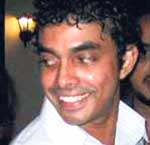
Business opportunities at Colombo Fashion Week
As the city buzzes with the Colombo Fashion Week (CFW) hype, those who work behind the glamorous scenes say that there is more to the event than simply looking good. Speaking to The Sunday Times FT, co-founder and organizer Ajai Vir Singh explained the hard-core business element present under it all. “I have always been a strong believer in the design sensibility of Sri Lanka” he enthuses, adding that the main objective of the event is to act as a launching pad for Sri Lankan designers. When the show was started in 2003, it was to merely to “test the waters” as he says, sticking to established names like Michael Wijesooriya, Yolande Aluwihare and Seneka De Silva.
When it re-emerged in 2007 –having been obstructed in the meanwhile because of tsunami related problems- the number of Sri Lankan designers doubled. For the two previous events Singh brought in a fair share of Indian designers like Satya Paul and Suneet Varma as well. “Many people ask me why, if I want to enhance the Sri Lankan industry, I bring in the Indian designers,” he says. The reason can be explained through the story of Sri Lankan Dharshi Keertisena. Keertisena was a virtually unknown designer when she showcased her work at the 2007 CFW. The organizers of the Bangalore Fashion Week who were present at the event were impressed enough to give her showing room at their own event. Indian retailers present there liked her designs and her new line was launched last year in two Indian stores.
Keerthisena, who says that to do a private show in Colombo is very expensive, is thankful to the CFW, “They really gave me the publicity I needed.” The crux of the matter is that within the short span of about a decade, the Indian fashion industry has gone through a major revolution. The fashion moguls of Paris and Milan have woken up to the expertise of the Indians, and consequently, most Indian shows invariably have their representatives present. “I think they (the Sri Lankan designers) stand a better chance to be picked up in India,” says Singh. Three new labels
Even designers who have already launched brands successfully will benefit; For Fahad Sheriff, owner of the emerging ‘Middle Finger’ brand name, which he refers to as , “100% Sri Lankan”, the event will be the opportunity to unveil the latest additions to his growing range. Describing the environment in Sri Lanka as “not very helpful”, he says that the difficulty arises when materials have to be bought, as they have to all be imported. The manufacturing is done in their own factories. Without an opportunity like this, the young designers face a disappointing fate. For most of them, the future lies in apparel firms dealing with big lines like Marks and Spencer’s and Victoria’s Secret. “They abandon the hope of having their own line and it’s a waste of talent,” says Singh. International media like Vogue, Cosmopolitan and Elle will be covering the event, a chance for global-level exposure for the designers. Also, the event will have three Indian designers, Mano Viraj Khosla, Neeta Lolla and Priyadharshini Rao, Bibi Russel from Bangladesh, Deepak Perwani from Pakistan and Italian label, ‘Sanchita’ showing. The organizers believe that the interaction with these fashion gurus alone will be invaluable for the aspiring designers.
The designers have been briefed with the latest trends in everything by the organizers, be it colour fabrics or styles. That way they are on par with everyone else in the global industry. The organizer is hopeful about the outcome, “When they (the Indian designers) show and the Sri Lankan designers show, there shouldn’t be any difference” Singh went on to explain an interesting element in fashion that most people don’t see. Designers –be they Giorgio Armani or Reethu Kumar- design a year ahead for a season. This is to make sure that when the season actually comes along, there will be adequate supplies for the retailers. In the same way, Singh and his team have given this year’s designers a focus. They have been designing since last year for the season of Spring/Summer 2008. This particular season was chosen mainly for two purposes: Sri Lanka there is in a perpetual spring season, and no particular winter season. More importantly, India is just readying itself to buy the Spring/Summer season. Back-end of fashion
The credibility of a designer doesn’t depend solely on his/her fashion sense. Having back-end services sorted out is equally important. The “ramps vs. racks” syndrome is often the problem. If a designer gets the attention of a foreign party, the next most important factor is having the clothes for buyers to stack their racks with. Into this comes the apparel industry. The fashion-apparel relationship is a weary one. In the past, the apparel people have shown minimum interest in the Sri Lankan designers. However, this year’s event has the support of Joint Apparel Association Forum (JAAF). Head of JAAF, Ajith Dias says, “This is the future. This is the best chance to enhance the image of the Sri Lankan garment industry”. A number of the major companies in the garment industry will be showcasing their lines as well, for the first time amongst international media exposure. Whereas in the past, the apparel sector dealt primarily with their international buyers, they are now extending their services to the local industry as well. Dias reiterates that the dependability and consistency of the Sri Lankan designers has risen greatly in the past few years. In retrospect, when one walks into the more popular retail stores in Colombo, there are a number of international brands on display, but hardly any authentic Sri Lankan work. With that in mind, Singh has a proposal for a small local retail network. “If they can’t enter the Indian market, which is asking a lot of them to try to work into such a large market, give them a chance here,” he says, adding that he is looking at convincing local retailers to afford some rack space for the young Sri Lankan designers. If the venture is properly marketed, it would generate more interest among the local public about the Sri Lankan industry. The clothing lines would be for the “middle and upper-middle classes”. They are meant be more reasonably priced than the international brands and more daily wear-friendly as opposed to the elaborate creations that most branded names offer. The emphasis of CFW is ‘serious fashion’. Behind the glitter, the real fashion industry is a competitive and hard-edged one. Events like the CFW aim at winning Sri Lanka a place in it. |
|
||||||
|
||||||
| || Front
Page | News
| Editorial
| Columns
| Sports
| Plus
| Financial
Times | International
| Mirror
| TV
Times | Funday Times || |
| |
Reproduction of articles permitted when used without any alterations to contents and the source. |
© Copyright
2008 | Wijeya
Newspapers Ltd.Colombo. Sri Lanka. All Rights Reserved. |





